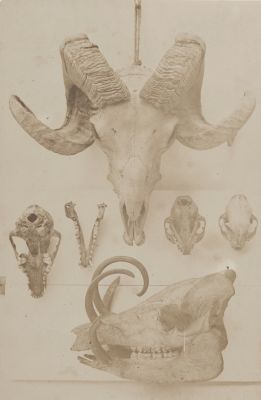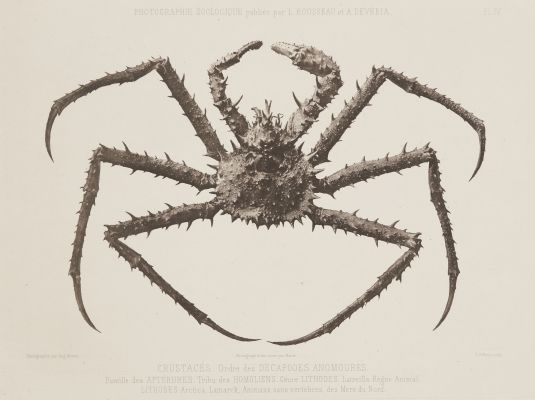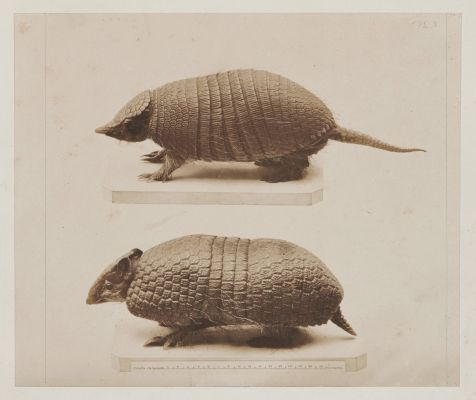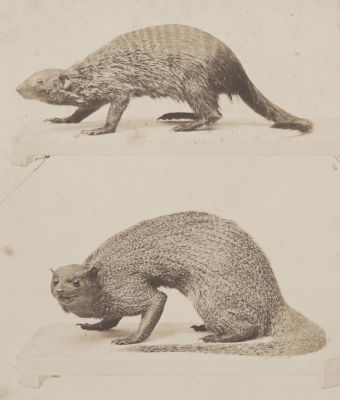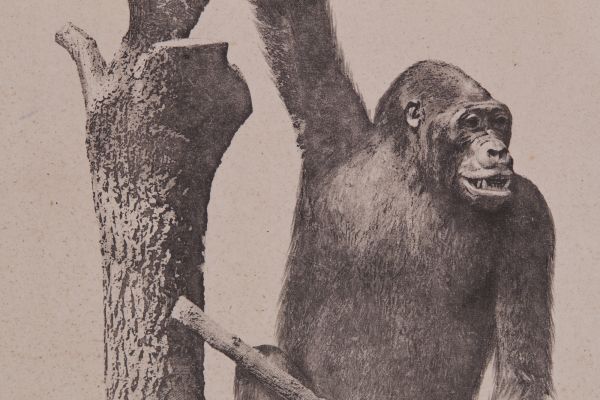
Title
Reptiles. Famille des Varaniens, Genre Varan MerreArtists
Bisson, Louis-Auguste (French, 1814-1876)Bisson, Auguste-Rosalie (French, 1826-1900)Publication
Photographie Zoologique Ou Représentation Des Animaux Rares Des Collections Du Muséum D'histoire NaturelleDate
1853Process
Photogravure (heliograph)Atelier
Mante and A. RiffautImage Size
24 x 17.6 cmSheet Size
37 x 27 cm
A landmark work bridging the invention of photography and it’s translation to permanent ink.
As the story goes, in 1825 Joseph Nicéphore Niépce commissioned his cousin, Colonel David Niépce, to purchase a new camera obscura from the Parisian optical shop of Charles Chevalier. While at the shop, “The Colonel” –as David Niépce was called—showed Chevalier examples of Niépce’s heliographic work, which surprised and impressed them. Chevalier shared the news of Niépce’s work with another shop patron, the artist and chemist Louis Daguerre, who in turn reached out to Niépce to discuss the possibility of collaborating. And voilà… the famous partnership now credited with the invention of photography was formed. Niépce’s original heliographic process was an extension of already well-established etching and lithography techniques. In his endeavors, Niépce had collaborated with the young engraver, Auguste-François Lemaître (1797–1870), to whom he owes much credit for his advancements engraving with light (which may be considered the essential origin point for both photography and photomechanical printing).
Cousin of the pioneer of the medium, Abel Niépce de Saint-Victor, returned to the principles of Joseph Nicéphore Niépce and, again like the elder Niépce, worked with the master printer Lemaître to perfect his process. Niépce de Saint-Victor’s two principal improvements were to make the bitumen of Judea more sensitive, and, after exposing the plate and dissolving the unhardened bitumen, dusting the plate with a layer of extremely fine rosin powder—i.e., adding an aquatint texture to hold the ink in large areas of tone.
Photogravures produced by his process were included in the 1853 volume Photographie zoologique ou représentation des animaux rares des collections du Muséum d’Histoire Naturelle by Louis Rousseau and Achille Deveria. The first fascicles of the volume were issued with salted paper prints by the Bisson frères tipped in, but subsequent fascicles took advantage of Niépce de Saint-Victor’s new technology; the volume is thus the first substantial publication to be illustrated with photogravures.
Writing about the book’s photogravure plates in his summary of photography at the Universal Exposition of 1855, Ernest Lacan claimed… "From now on, it is proved that heliographic engraving can lend itself to all applications of photography … Soon, we are convinced, it will bring a real revolution in the bookstore. A day will come, in fact, when the historian, the traveler, the naturalist, will no longer wish to entrust the illustration of their books to the engravers." More surprising than that, this most enthusiastic critic and publicist for photography declared that "For us photography, so complete as it is in its results, is only a transient process, and it is to gravure or photolithography that the future belongs." [1]
Reproduced / Exhibited
Hanson, David A. Checklist of Photomechanical Processes and Printing, 1825-1910. , 2017. p. 86
References
[1] Daniel, Malcolm, The Beginnings of Photogravure in Nineteenth-Century France, essay is adapted from a paper first presented at a colloquium on photogravure at the Institute for Research in Art / Graphicstudio, University of South Florida, Tampa, March 22-24, 1995.
Bann, Stephen. “Photographie Et Reproduction Gravée: L’ Économie Visuelle Au Xixe Siècle.” Etudes Photographiques / Société Française De Photographie. (2001): 22-43. Print.
Comptes Rendus Hebdomodaires des Sceances de I’Academie des Sciences, Note sur la gravure heliograptiique sur plaque d’acier. C. F- A. Niepce de Saint-Victor (May 23, 1853)
Correspondence between Joseph-Nicéphore Niépce, at Chalons, and M. Lemaitre, engraver at Paris, La Lumière, 1851, n. 1-9. Letter, January 1, 1827.
Eder, Josef M, and Edward Epstean. History of Photography. New York: Dover Publications, 1978.
Frizot, Michel, Aubenas, Sylvie The Photograph in Print, Multiplication and Stability of the Image. A New History of Photography, 1999
Gernsheim, Helmut. The Origins of Photography. London: Thames and Hudson, 1982 p. 37
Hammann, J.-M.-Herman. Des Arts Graphiques Destinés a Multiplier Par L’impression: Considérés Sous Le Double Point De Vue Historique Et Pratique. Genève [etc.: JoëlCherbuliez, 1857 P. 451
Rosen, Jeff. “Naming and Framing ‘Nature’ In Photographie Zoologique.” Word & Image. 13.4 (1997): 377-391.
Rosen, Jeff The Printed Photograph and the Logic of Progress in Nineteenth-Century France Jeff Rosen Art Journal, Vol. 46, No. 4, The Political Unconscious in Nineteenth-Century Art (Winter, 1987), pp. 305-311
The Evolution of the Modern Lens. Address of the President, Mr. T. R. Dallmeyer, F. R. A. S., Etc., before the Royal Photographic Society, London, October 9, 1900. Reprinted from “The Photographic News.” (Anthony’s Photographic Bulletin, Volume 31: 384).
Translation of Niépce de St. Victor article from the 31 October 1853 issue of La Lumière on heliographic engraving on steel plates appears in The Photographic and Fine Art Journal [7:3 (March), pp. 76-77] and later that year in Humphrey’s Journal[6:16 (Dec. 1), pp. 241-45].
Towler, John. The Silver Sunbeam. Joseph H. Ladd, New York: 1864 CH 40
The Photographic News. Place of publication not identified: publisher not identified, October 19, 1900.
Thierry Laugée, "Zoological Photography, Achille Devéria and Louis Rousseau", BNF Review 2017/1 (No. 54), p. 120-129
